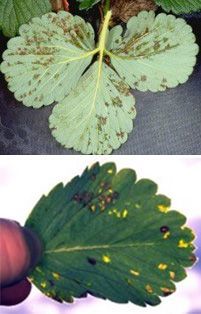This new two-page publication of the UF/IFAS Department of Plant Pathology describes symptoms of most common strawberry diseases in Florida and summarizes the efficacy of fungicides labeled for management of such diseases. This publication is best viewed as a PDF.
Fungal
Phytophthora Crown Rot (Phytophthora cactorum)

Credit: UF/IFAS
Colletotrichum Crown rot (Colletotrichum gloeosporioides)

Credit: UF/IFAS
Charcoal Rot (Macrophomina phaseolina)

Credit: UF/IFAS
Botrytis Fruit Rot (Botrytis cinerea)

Credit: UF/IFAS
Anthracnose Fruit Rot (Colletotrichum acutatum)

Credit: UF/IFAS
Powdery Mildew (Podosphaera aphanis)

Credit: UF/IFAS
Pestalotia Leaf Spot and Fruit Rot (Neopestalotiopsis sp.)

Credit: UF/IFAS
Leather Rot (Phytophthora cactorum or P. nicotianae)

Credit: UF/IFAS
Phomopsis Leaf Blight and Soft Rot (Phomopsis obscurans)

Stem-End Rot and Leaf Blotch (Gnomonia comari)

Credit: UF/IFAS
Bacterial
Angular Leaf Spot (Xanthomonas fragariae)

Credit: UF/IFAS
Resources

Credit: UF/IFAS